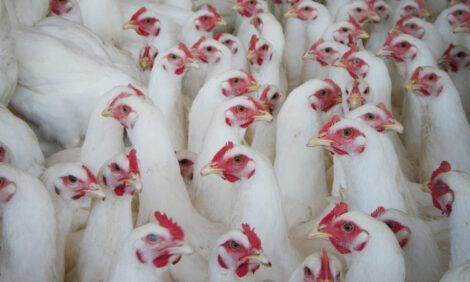



Nutrient Deposition and Energy Utilisation in Slow-growing Broilers Fed with Organic Diets
The growth patterns of slow-growing male and female broilers in organic systems were found to be so different by a group of researchers in Germany that they recommend using separate feeding programmes for rearing the sexes in these systems.An experiment was carried out to study the growth parameters, body composition, nutrients deposition and energy requirements of male and female slow-growing broilers (ISA J-257) fed with organic diets by S. Carrasco from the University of Applied Sciences in Freising Weihenstephan and co-authors.
In the journal, Livestock Science, they report that reduced energy (less than 12MJ Apparent Metabolisable Energy, AME per kg) and essential amino acids (EAA) organic diets were used.
A total of 972 day old male and female broilers were used and samples of them were weighed and slaughtered at 0, 14, 28, 42 and 56 days of age.
The whole body was analysed to calculate protein, fat and energy deposition. Gompertz growth parameters for the mentioned variables were estimated; also the energy for maintenance (MEm) requirements and the efficiencies of energy utilisation for fat and protein deposition were determined.
From 28 days of age, the whole body of males was heavier than females (P<0.05). The dry matter (P<0.001) and fat content (P<0.01) of females were higher than males.
Diet affected only the dry matter content (P<0.01), thus diets with high AME and EAA (diet 1 and 2) induced higher dry matter content in the whole body.
Males showed a greater potential to deposit protein (P<0.001) from 42 days of age and energy (P<0.05) at 56 days of age than females.
These results were confirmed with the estimated high growth Gompertz parameters of males and reflected their superior growth potential in comparison to females.
Compared to the males, the females reached earlier their:
- maximum growth rate - at 40 days: 45.2g per day compared to 60.6g per day at 51 days of age for the males
- protein deposition rate - at 39 days: 9.0g per day compared to 12.7g per day at 55 days for the males and
- energy deposition rate - at 47 days: 502.9KJ per day compared to 678.7KJ per day at 56 days for the males.
However, the females reached their maximum fat deposition rate one day later than the males - 7.8g per day at 54 days and 9.3g per day at 53 days, respectively.
The rates of maximum growth rate, protein deposition, fat deposition and energy deposition by females were 25.4 per cent, 29, 16 and 26 per cent, respectively, lower than those of males.
The parameters of the partitioning of ME indicate that males tended to spend more ME on maintenance (MEm: 540.8 versus 528.3kJ per kg0.75 per day), protein deposition (43.0 versus 41.8kJ per gramme) and fat deposition (31.5 versus 31.0kJ per gramme) than females.
Consequently, the males presented slightly lower efficiencies of energy utilisation for fat (kf; 1.2 versus 1.3) and for protein (kp; 0.5 versus 0.6) than females.
These differences between males and females indicate that they do not have the same nutritional requirements, concluded Carrasco and co-authors. In order to optimise the use of nutrients and to avoid the waste of protein, males and females require different feeding programmes in the organic production of slow-growing broilers.
Reference
Carrasco S., G. Bellof and E. Schmidt. 2014. Nutrients deposition and energy utilization in slow-growing broilers fed with organic diets containing graded nutrient concentration. Livestock Science. 161:114-122.
March 2014











